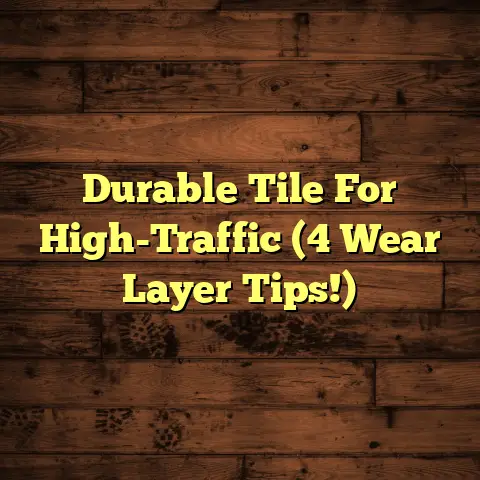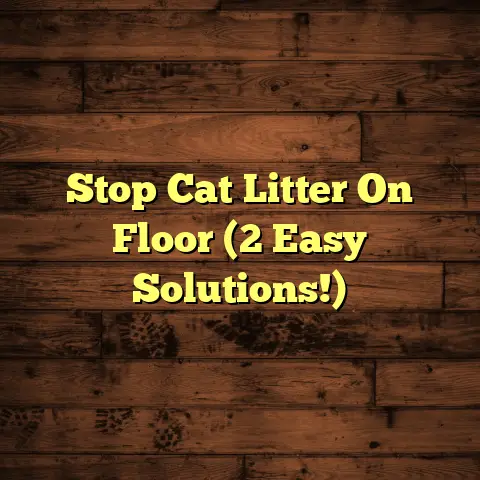Dark Spots On Wood Floors: Causes? (4 Call-A-Pro Signs!)
Wood flooring, am I right?
It’s a timeless choice, adding warmth and elegance to any space.
I’ve installed countless wood floors over the years, from rustic farmhouses to sleek modern apartments.
It complements everything, from your grandma’s antique furniture to the latest minimalist trends.
But let’s be honest, wood floors aren’t invincible.
One common headache I see time and again?
Dark spots.
These pesky blemishes can really detract from your floor’s beauty.
And more importantly, they can signal underlying problems.
That’s why understanding what causes these spots and when to call in a pro is crucial.
Trust me, catching these issues early can save you a ton of money and heartache down the road.
So, let’s dive in and get your wood floors looking their best!
1. Understanding Dark Spots on Wood Floors
Alright, so what exactly are we talking about when we say “dark spots”?
Well, they’re pretty much what they sound like: areas on your wood floor that are noticeably darker than the surrounding wood.
They can range in size from tiny pinpricks to larger, more irregular blotches.
The color can vary, too, from a light tan to a deep, almost black hue.
Now, it’s important to distinguish these from other types of damage.
Scratches are usually surface-level and appear as lighter lines.
Dents, on the other hand, are depressions in the wood.
Dark spots are different – they’re discoloration within the wood itself.
Think of it like a stain that’s seeped into the material.
I’ve seen firsthand how these spots can affect homeowners.
It’s more than just aesthetics, you know?
A pristine wood floor evokes a sense of pride and comfort.
But those dark spots? They can be a constant source of frustration.
They can make a room feel dingy or neglected, even if everything else is spotless.
Plus, there’s the worry about what’s causing them.
Is it something serious? Is it going to spread?
Addressing these spots promptly can alleviate these concerns and restore your peace of mind.
2. Common Causes of Dark Spots on Wood Floors
Okay, let’s get down to the nitty-gritty.
What’s actually causing these dark spots to appear on your beautiful wood floors?
Here are some of the most common culprits I’ve encountered over the years:
2.1 Water Damage
Water is enemy number one for wood floors.
When water seeps into the wood, it can cause a whole host of problems, including dark spots.
The wood absorbs the moisture, creating a breeding ground for mold and mildew.
These organisms then feed on the wood, leading to discoloration and decay.
I remember one client who had a slow leak under their kitchen sink for months.
They didn’t notice it until a large, dark stain appeared on their hardwood floor.
By that point, the damage was extensive, and required replacing a significant section of the flooring.
Spills are another common cause.
Think about it: a spilled glass of water, a leaky ice maker, or even just consistently damp mopping can all contribute to water damage.
Even seemingly harmless things like potted plants without proper drainage can cause issues.
The water can seep through the pot and into the floor, creating a hidden problem.
How to Prevent Water Damage:
- Clean up spills immediately.
- Use mats and rugs in high-traffic areas and near water sources.
- Ensure proper ventilation in bathrooms and kitchens.
- Check for leaks regularly, especially under sinks and around appliances.
- Avoid over-wetting the floor when mopping.
2.2 Pet Urine
Ah, pets. We love them, but sometimes they can be a little… messy.
Pet urine is a particularly nasty offender when it comes to wood floors.
It’s not just the smell (which is bad enough!), but the chemical composition of urine can react with the wood finish and the wood itself, causing dark stains.
The uric acid in urine is especially corrosive.
It can penetrate the finish and seep into the wood fibers, leading to permanent discoloration.
And the longer the urine sits, the worse the damage becomes.
I’ve seen cases where pet urine has completely ruined sections of hardwood flooring, requiring costly repairs.
Untreated pet stains can also lead to other problems.
The moisture can encourage mold growth, and the odor can linger even after cleaning.
How to Prevent Pet Urine Stains:
- Clean up accidents immediately.
- Use an enzymatic cleaner specifically designed for pet stains.
- Consider using waterproof mats or rugs in areas where pets frequent.
- Train your pets to eliminate outdoors.
- Regularly inspect your floors for any signs of accidents.
2.3 Sunlight Exposure
You might not think of sunlight as a major threat to your wood floors, but it can actually cause significant damage over time.
Prolonged exposure to UV rays can cause the wood to fade or discolor, leading to uneven coloring and dark spots.
This is especially true for darker wood species, which tend to absorb more sunlight.
The UV rays break down the lignin in the wood.
Lignin is the substance that gives wood its color and strength.
As the lignin breaks down, the wood can become lighter or darker in certain areas, creating a patchy, uneven appearance.
I’ve seen entire rooms where the wood floor near the windows is significantly lighter than the wood under rugs or furniture.
This can create a really jarring effect, and it’s difficult to correct without refinishing the entire floor.
How to Prevent Sunlight Damage:
- Use curtains, blinds, or shades to block direct sunlight.
- Apply UV-resistant window film to your windows.
- Rotate rugs and furniture regularly to ensure even exposure.
- Consider using a wood finish with UV inhibitors.
2.4 Mold and Mildew
Mold and mildew are fungi that thrive in damp, humid environments.
They can grow on wood floors, especially in areas with poor ventilation or high moisture levels.
Mold and mildew not only cause discoloration but can also damage the wood structure over time.
These organisms feed on organic materials, including wood.
As they grow, they release enzymes that break down the wood fibers, weakening the floor.
I’ve seen cases where mold and mildew have caused significant rot, requiring extensive repairs.
Mold and mildew can also pose health risks.
They can trigger allergies, asthma, and other respiratory problems.
If you suspect you have mold or mildew on your wood floors, it’s important to address the problem immediately.
How to Prevent Mold and Mildew:
- Ensure proper ventilation in your home, especially in bathrooms and kitchens.
- Use a dehumidifier to control moisture levels.
- Clean up spills immediately.
- Repair any leaks promptly.
- Regularly inspect your floors for signs of mold or mildew.
3. Identifying When to Call a Professional
Okay, so you’ve identified some dark spots on your wood floor.
Now what?
How do you know whether you can tackle the problem yourself or if it’s time to call in a professional?
That’s where these “Call-A-Pro” signs come in.
These are red flags that indicate a more serious underlying issue that requires expert attention.
3.1 Persistent Dark Spots
You’ve tried cleaning the spots with a mild detergent.
You’ve even tried a wood-specific cleaner.
But the dark spots just won’t budge.
If you’ve exhausted your DIY cleaning efforts and the spots are still there, it’s a sign that the damage may be deeper than you think.
The discoloration may have penetrated the finish and seeped into the wood fibers.
In these cases, professional refinishing or even replacement may be necessary.
I’ve seen homeowners spend hours scrubbing at stubborn stains, only to realize that they were just making the problem worse.
Sometimes, it’s best to cut your losses and call in a pro.
3.2 Extensive Damage
A few small dark spots might not seem like a big deal.
But if you’re seeing widespread discoloration, or if the spots are large and deep-seated, it’s a sign that the problem is more serious.
Extensive damage can indicate a major water leak, a severe mold infestation, or other underlying issues.
These problems can compromise the structural integrity of your floor and even affect the air quality in your home.
I remember one client who ignored a small water stain in their bathroom for months.
By the time they called me, the entire subfloor was rotten, and they had to replace the entire bathroom floor.
3.3 Structural Concerns
Dark spots aren’t always just cosmetic issues.
Sometimes, they can be a sign of structural damage.
If you notice that your floor is warped, buckled, or feels soft or spongy in certain areas, it’s a major red flag.
This can indicate that the wood is rotting or that the subfloor is damaged.
Structural damage can be dangerous and can even lead to collapses.
If you suspect structural damage, it’s crucial to call a professional immediately.
Don’t try to fix it yourself.
3.4 Health Risks
As I mentioned earlier, mold and mildew can pose health risks.
If you suspect that the dark spots on your floor are caused by mold or mildew, it’s important to take precautions.
Avoid direct contact with the affected area, and wear a mask and gloves if you need to clean it.
If you have any respiratory problems, it’s best to leave the cleaning to a professional.
Mold remediation can be a complex process, and it’s important to ensure that the problem is completely eradicated to prevent future health issues.
Here’s a quick table summarizing the “Call-A-Pro” signs:
4. Conclusion
So, there you have it.
A comprehensive look at dark spots on wood floors, their causes, and when to call in a professional.
Remember, understanding the root cause of these spots is key to preventing further damage and maintaining the beauty and integrity of your floors.
Don’t ignore those dark spots!
Regularly inspect your wood floors for any signs of discoloration, water damage, or structural issues.
The sooner you address these problems, the better.
And when in doubt, don’t hesitate to call a professional.
A qualified flooring contractor can assess the situation, identify the underlying cause, and recommend the best course of action.
Trust me, it’s better to be safe than sorry.
Your wood floors are a valuable investment, and with proper care and maintenance, they can last for generations.
So, take care of them, and they’ll take care of you!





